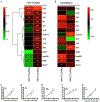Toll-like receptor 3 dynamics in female C57BL/6J mice: Regulation of alcohol intake
- PMID: 30550930
- PMCID: PMC6399033
- DOI: 10.1016/j.bbi.2018.12.006
Toll-like receptor 3 dynamics in female C57BL/6J mice: Regulation of alcohol intake
Abstract
Although there are sex differences in the effects of alcohol on immune responses, it is unclear if sex differences in immune response can influence drinking behavior. Activation of toll-like receptor 3 (TLR3) by polyinosinic:polycytidylic acid (poly(I:C)) produced a rapid proinflammatory response in males that increased alcohol intake over time (Warden et al., 2019). Poly(I:C) produced a delayed and prolonged innate immune response in females. We hypothesized that the timecourse of innate immune activation could regulate drinking behavior in females. Therefore, we chose to test the effect of two time points in the innate immune activation timecourse on every-other-day two-bottle-choice drinking: (1) peak activation; (2) descending limb of activation. Poly(I:C) reduced ethanol consumption when alcohol access occurred during peak activation. Poly(I:C) did not change ethanol consumption when alcohol access occurred on the descending limb of activation. Decreased levels of MyD88-dependent pathway correlated with decreased alcohol intake and increased levels of TRIF-dependent pathway correlated with increased alcohol intake in females. To validate the effects of poly(I:C) were mediated through MyD88, we tested female mice lacking Myd88. Poly(I:C) did not change alcohol intake in Myd88 knockouts, indicating that poly(I:C)-induced changes in alcohol intake are dependent on MyD88 in females. We next determined if the innate immune timecourse also regulated drinking behavior in males. Poly(I:C) reduced ethanol consumption in males when alcohol was presented at peak activation. Therefore, the timecourse of innate immune activation regulates drinking behavior and sex-specific dynamics of innate immune response must be considered when designing therapeutics to treat excessive drinking.
Keywords: Alcohol; Alcohol use disorder; Cytokines; Drinking; Females; Neuroimmune; Poly(I:C); Sex; Toll-like receptors.
Copyright © 2018 Elsevier Inc. All rights reserved.
Figures








Similar articles
-
Toll-like receptor 3 activation increases voluntary alcohol intake in C57BL/6J male mice.Brain Behav Immun. 2019 Mar;77:55-65. doi: 10.1016/j.bbi.2018.12.004. Epub 2018 Dec 11. Brain Behav Immun. 2019. PMID: 30550931 Free PMC article.
-
Ethanol Consumption in Mice Lacking CD14, TLR2, TLR4, or MyD88.Alcohol Clin Exp Res. 2017 Mar;41(3):516-530. doi: 10.1111/acer.13316. Epub 2017 Feb 1. Alcohol Clin Exp Res. 2017. PMID: 28146272 Free PMC article.
-
Inbred Substrain Differences Influence Neuroimmune Response and Drinking Behavior.Alcohol Clin Exp Res. 2020 Sep;44(9):1760-1768. doi: 10.1111/acer.14410. Epub 2020 Aug 2. Alcohol Clin Exp Res. 2020. PMID: 32640038 Free PMC article.
-
Role of corticosterone in immunosuppressive effects of acute ethanol exposure on Toll-like receptor mediated cytokine production.J Neuroimmune Pharmacol. 2006 Dec;1(4):435-42. doi: 10.1007/s11481-006-9037-z. Epub 2006 Aug 4. J Neuroimmune Pharmacol. 2006. PMID: 18040816 Review.
-
A Comprehensive Review of poly(I: C) as a Tool for Investigating Astrocytic TLR3 Signaling.Neurochem Res. 2025 Apr 2;50(2):133. doi: 10.1007/s11064-025-04381-3. Neurochem Res. 2025. PMID: 40172723 Review.
Cited by
-
Inhibition of the Inflammasome Signaling Cascade Reduces Alcohol Consumption in Female But Not Male Mice.Alcohol Clin Exp Res. 2020 Feb;44(2):567-578. doi: 10.1111/acer.14272. Epub 2020 Jan 9. Alcohol Clin Exp Res. 2020. PMID: 31854009 Free PMC article.
-
Sex-dependent factors of alcohol and neuroimmune mechanisms.Neurobiol Stress. 2023 Aug 3;26:100562. doi: 10.1016/j.ynstr.2023.100562. eCollection 2023 Sep. Neurobiol Stress. 2023. PMID: 37601537 Free PMC article.
-
Binge alcohol and the neuroendocrinology of the aging female.Front Neuroendocrinol. 2025 Jul;78:101201. doi: 10.1016/j.yfrne.2025.101201. Epub 2025 Jun 4. Front Neuroendocrinol. 2025. PMID: 40480422 Review.
-
Role of toll-like receptor 7 (TLR7) in voluntary alcohol consumption.Brain Behav Immun. 2020 Oct;89:423-432. doi: 10.1016/j.bbi.2020.07.029. Epub 2020 Jul 26. Brain Behav Immun. 2020. PMID: 32726684 Free PMC article.
-
Sex Differences in the Brain Transcriptome Related to Alcohol Effects and Alcohol Use Disorder.Biol Psychiatry. 2022 Jan 1;91(1):43-52. doi: 10.1016/j.biopsych.2021.04.016. Epub 2021 May 1. Biol Psychiatry. 2022. PMID: 34274109 Free PMC article. Review.
References
-
- Leclercq S, De Saeger C, Delzenne N, de Timary P, Starkel P (2014): Role of inflammatory pathways, blood mononuclear cells, and gut-derived bacterial products in alcohol dependence. Biol Psychiatry. 76:725–733. - PubMed
-
- Montesinos J, Alfonso-Loeches S, Guerri C (2016): Impact of the Innate Immune Response in the Actions of Ethanol on the Central Nervous System. Alcohol Clin Exp Res 40:2260–2270. - PubMed
-
- Hutchins JB, Allen DL, Cole-Harding LS, Wilson JR (1981): Behavioral and physiological measures for studying ethanol dependence in mice. Pharmacol Biochem Behav 15:55–59. - PubMed
Publication types
MeSH terms
Substances
Grants and funding
LinkOut - more resources
Full Text Sources
Medical
Molecular Biology Databases

